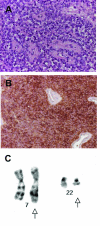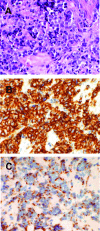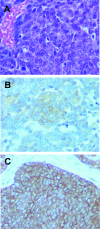Undifferentiated small round cell sarcomas with rare EWS gene fusions: identification of a novel EWS-SP3 fusion and of additional cases with the EWS-ETV1 and EWS-FEV fusions
- PMID: 17690209
- PMCID: PMC1975108
- DOI: 10.2353/jmoldx.2007.070053
Undifferentiated small round cell sarcomas with rare EWS gene fusions: identification of a novel EWS-SP3 fusion and of additional cases with the EWS-ETV1 and EWS-FEV fusions
Abstract
Ewing family tumors (EFTs) are prototypical primitive small round blue cell sarcomas arising in bone or extraskeletal soft tissues in children or adolescents. EFTs show fusions of EWS with a gene of the ETS family of transcription factors, either EWS-FLI1 (90 to 95%) or EWS-ERG (5 to 10%). Rare cases with fusions of EWS to other ETS family genes, such as ETV1, E1AF, and FEV, have been identified, but their clinicopathological similarity to classic EFTs remains unclear. We report four new cases of EFT-like tumors with rare EWS fusions, including two with EWS-ETV1, one with EWS-FEV, and a fourth case in which we cloned a novel EWS-SP3 fusion, the first known cancer gene fusion involving a gene of the Sp zinc finger family. Analysis of these three new cases along with data on nine previously reported cases with fusions of EWS to ETV1, E1AF, or FEV suggest a strong predilection for extraskeletal primary sites. EFT-like cases with fusions of EWS to non-ETS translocation partners are also uncommon but involve the same amino-terminal portion of EWS, which in our novel EWS-SP3 fusion is joined to the SP3 zinc-finger DNA-binding domain. As these data further support, these types of EWS fusions are associated with primitive extraskeletal small round cell sarcomas of uncertain lineage arising mainly in the pediatric population.
Figures








Comment in
-
Molecular diagnosis of ewing family tumors: too many fusions... ?J Mol Diagn. 2007 Sep;9(4):437-40. doi: 10.2353/jmoldx.2007.070080. Epub 2007 Jul 25. J Mol Diagn. 2007. PMID: 17652636 Free PMC article.
References
-
- Delattre O, Zucman J, Plougastel B, Desmaze C, Melot T, Peter M, Kovar H, Joubert I, de Jong P, Rouleau G, Aurias A, Thomas G. Gene fusion with an ETS DNA-binding domain caused by chromosome translocation in human tumours. Nature. 1992;359:162–165. - PubMed
-
- Zucman J, Melot T, Desmaze C, Ghysdael J, Plougastel B, Peter M, Zucker JM, Triche TJ, Sheer D, Turc-Carel C, Ambros P, Combaret V, Lenoir G, Aurias A, Thomas G, Delattre O. Combinatorial generation of variable fusion proteins in the Ewing family of tumours. EMBO J. 1993;12:4481–4487. - PMC - PubMed
-
- Delattre O, Zucman J, Melot T, Garau XS, Zucker JM, Lenoir GM, Ambros PF, Sheer D, Turc-Carel C, Triche TJ, Aurias A, Thomas G. The Ewing family of tumors—a subgroup of small-round-cell tumors defined by specific chimeric transcripts. N Engl J Med. 1994;331:294–299. - PubMed
-
- Sharrocks AD. The ETS-domain transcription factor family. Nat Rev Mol Cell Biol. 2001;2:827–837. - PubMed
-
- Sorensen PHB, Lessnick SL, Lopez-Terrada D, Liu XF, Triche TJ, Denny CT. A second Ewing’s sarcoma translocation, t(21;22), fuses the EWS gene to another ets-family transcription factor, ERG. Nat Genet. 1994;6:146–151. - PubMed
Publication types
MeSH terms
Substances
LinkOut - more resources
Full Text Sources
Research Materials

